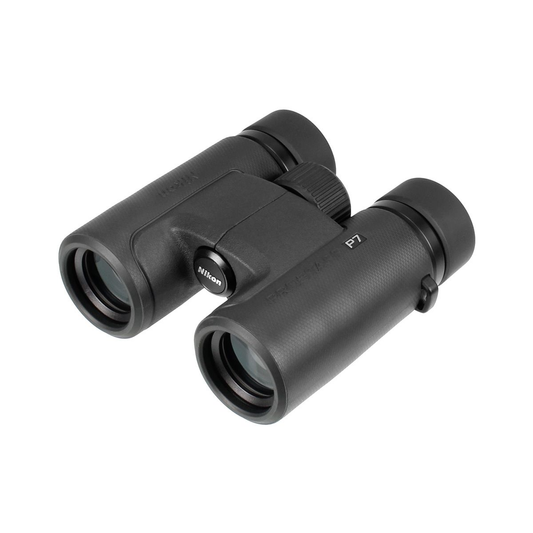

Nikon PROSTAFF P7 8x30mm Binoculars (16770) deliver high-definition viewing with advanced optical technology tailored for outdoor enthusiasts. With an 8x magnification and a 30mm objective lens, these binoculars provide bright visuals and true-to-life colors, thanks to multi-layer prism coatings that enhance light transmission. The compact design makes them a perfect choice for birdwatching, hiking, and wildlife observation, easily fitting into your backpack for hands-free exploration.
Featuring a generous field of view of 456 feet at 1000 yards, tracking moving subjects becomes effortless. Constructed with a fiberglass-reinforced polycarbonate frame and a rubber-armored exterior, the PROSTAFF P7 is built to withstand the rigors of outdoor use. The binoculars are also designed with user comfort in mind, incorporating turn-and-slide eyecups that cater to both eyeglass wearers and non-wearers. Nikon's eco-friendly optics ensure peace of mind with lead and arsenic-free materials.
Features – Key Benefits Bullets
- HIGH-DEFINITION OPTICS: Equipped with dielectric high-reflective multi-layer coatings for maximum clarity and color fidelity.
- GENEROUS VIEWING: Immense field of view, ideal for tracking fast-moving subjects in the great outdoors.
- CUSTOMIZABLE FOCUS: Locking diopter ring ensures your settings remain constant throughout use.
- USER FRIENDLY: Comfortable turn-and-slide eyecups designed to accommodate all viewers, with or without glasses.
- DURABLE CONSTRUCTION: Made of tough fiberglass-reinforced polycarbonate resin with a rugged rubber armored exterior.
- ALL-WEATHER PERFORMANCE: Water, fog, and oil repellent coatings keep your lenses clear in challenging conditions.
- SUSTAINABLE DESIGN: Lead and arsenic-free Eco-Glass for environmentally conscious consumers.
- TRAVEL-READY: Lightweight and includes accessories for ease of mobile use and protection.
Technical Specifications
| Specification | Details |
|---|---|
| Weight | 17.1 ounces |
| Dimensions | Length: 4.9 inches |
| Field of View | 456 feet @ 1000 yards |
| Objective Diameter | 30mm |
| Product Type | Binoculars |
| Item Condition | New |
| UPC | 018208167708 |
| MPN | 16770 |
WHAT'S IN THE BOX?
Included with the Nikon PROSTAFF P7 8x30mm Binoculars are:
- Nikon PROSTAFF P7 8x30mm Binoculars (16770)
- Eyepiece Cap
- Objective Lens Cap
- Case
- Neckstrap
Customer Reviews
“These binoculars are perfect for birdwatching. The clarity is impressive, and they feel solid in hand.”
“Great for hiking! They are lightweight and the field of view is fantastic.”
“I love the eco-friendly design. It’s nice to have quality optics that are also environmentally conscious.”
FAQ
How do the Nikon PROSTAFF P7 perform in low light conditions?
These binoculars feature advanced multi-layer coatings that enhance light transmission, enabling better visibility during dawn or dusk. This makes them suitable for wildlife observation during those times.
Are they suitable for use with glasses?
Yes, the PROSTAFF P7 binoculars include turn-and-slide eyecups, which can be adjusted comfortably for users with eyeglasses, providing optimal viewing without obstruction.
How durable are these binoculars for outdoor activities?
The fiberglass-reinforced polycarbonate construction, combined with rubber armor, ensures that the binoculars are shock-resistant and can withstand various outdoor environments, including wet and rugged conditions.
What maintenance is required for these binoculars?
Regular cleaning of the lenses with a microfiber cloth is recommended. Avoid exposing the binoculars to harsh chemicals or extreme temperatures to maintain their longevity.
How do they compare to other binoculars in this price range?
The Nikon PROSTAFF P7 offers high-definition optics and a robust build quality, making them competitive with models from brands like Bushnell and Vortex at a similar price point, with added eco-friendly benefits.
Similar Models
Looking for more options? Explore our extensive Nikon collection, including the Nikon MONARCH 5 8x42 for enhanced light-gathering capability and the compact Nikon Aculon A211 8x42 for versatile outdoor use. Check out our full range to find the perfect binoculars for your next adventure.
You May Also Like
Here’s some of our most similar products people are buying. Click to discover trending style.










